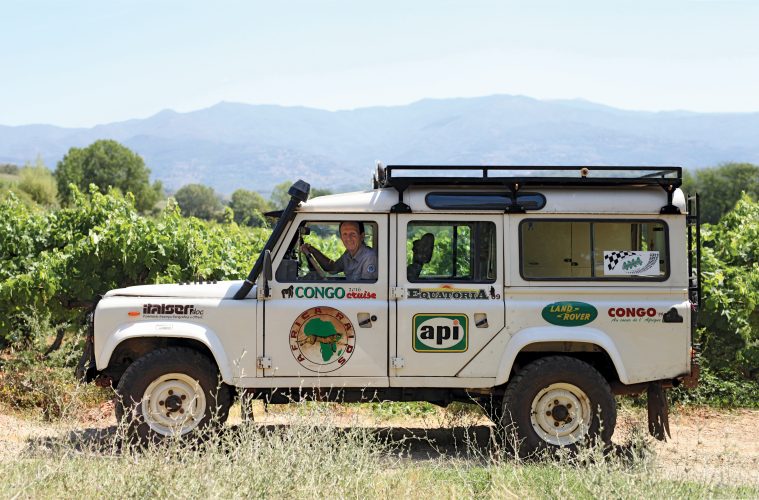For over 30 years, Moreno Torricelli has immersed himself in the many nations and cultures of Africa aboard his ’86 Land Rover 110. I had the good fortune to interview one of Italy’s most storied African travelers.
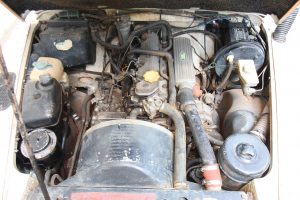
Moreno reflected on his first trip to the African continent. “I saw Africa for the very first time from a boat that went up the Nile in 1983, and I couldn’t believe my eyes. I immediately decided that I wanted to go back and see the whole country. When I returned to Italy, I began to read everything I could find about this part of the world. In particular I was interested (and still am) in the travel memories of the mid-nineteenth century explorers who ventured into Africa: Orazio Antinori, Carlo Piaggia, Vittorio Bottego, Heinrich Barth, John Speke, Richard Burton, Pierre Savorgnan, David Livingstone and Henry Stanley. While I was reading their words, unconsciously I was already imagining my future travels.”
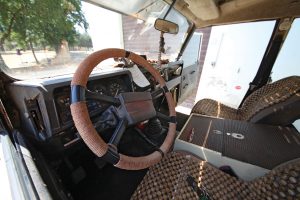
In Italian, we humorously call his fascination with Africa a “Mal d’Africa”, but Moreno deflected that description. “I don’t define my passion and interest about Africa as a sick obsession. I would say that Africa is always there in my thoughts, and simply thinking of returning there comforts me. Maybe I do have a touch of ‘Mal d’Africa’”!
It’s not surprising that Moreno’s many travels through the African continent have been made in a Land Rover. “When I decided to visit Africa in my own way, I decided to do it with a Land Rover. I’ve regretted this choice. I bought it brand new from the Autosalone Montecarlo in Florence, which delivered it to me in February 1986. I’ve made all my travels in this one, my only off-road vehicle.”
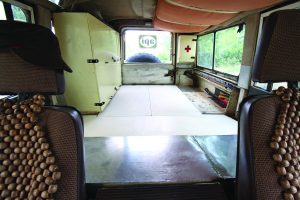 “I worked as a race car mechanic when I was a boy; I have personally made all the changes on the car. Every time I came back from Africa I added something, but taking care not to add anything superfluous (what you don’t bring with it won’t break). As equipped and provisioned, I can drive for more than 3,000 km on paved roads, and about 2,000 km off-road.”
“I worked as a race car mechanic when I was a boy; I have personally made all the changes on the car. Every time I came back from Africa I added something, but taking care not to add anything superfluous (what you don’t bring with it won’t break). As equipped and provisioned, I can drive for more than 3,000 km on paved roads, and about 2,000 km off-road.”
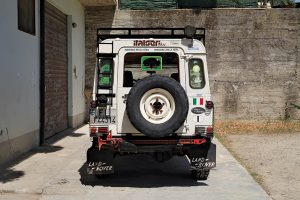 “I’ve built my own roof rack and ladder and I carry a folding table and chairs. I’ve installed mounts for a jack and shovel, as well as a bullbar, winch, additional lighting, two spare wheels and two gas tanks, one behind the front seats and one underneath the passenger seat. A 70-liter water tank with an electric pump sits on the rear right wheel well. And I constructed wooden boxes and cabinets for food, tools, clothes, first aid kit, and an air compressor.”
“I’ve built my own roof rack and ladder and I carry a folding table and chairs. I’ve installed mounts for a jack and shovel, as well as a bullbar, winch, additional lighting, two spare wheels and two gas tanks, one behind the front seats and one underneath the passenger seat. A 70-liter water tank with an electric pump sits on the rear right wheel well. And I constructed wooden boxes and cabinets for food, tools, clothes, first aid kit, and an air compressor.”
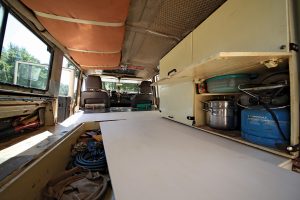 Puzzled by the absence of a roof tent, I asked Moreno about his sleeping quarters. “For safety reasons I usually sleep inside the Land Rover. I always want to be ready to turn on the engine and drive away from possible risks (not only dangerous animals). When it’s too hot to sleep inside the car, I have a small tent that I put on the roof, but I don’t use it too often.”
Puzzled by the absence of a roof tent, I asked Moreno about his sleeping quarters. “For safety reasons I usually sleep inside the Land Rover. I always want to be ready to turn on the engine and drive away from possible risks (not only dangerous animals). When it’s too hot to sleep inside the car, I have a small tent that I put on the roof, but I don’t use it too often.”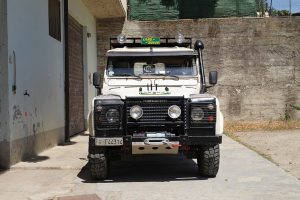
Many adventurers seek sponsorship to help cover the expenses of their travels, but Moreno prefers to go at it alone. “I never had a sponsor. In over 30 years of traveling I’ve always had to pay for everything. Sometimes my friends gave me some tools or gear. Also, I was fortunate to sell some of my Africa photographs to magazines.”
I asked Moreno about the pros and cons of traveling alone in potentially dangerous places. “At first, I did travel with friends, but after a few years I developed enough confidence in myself and my Land Rover 110, which I carefully prepare before every departure.”
 “Traveling alone means having great self-confidence and complete trust in the vehicle that you are driving. You can work on your schedule and route. You can go very far in just one day or stop for a long time in one place. You don’t have to discuss what to do with anyone. You can make decisions much more quickly, then do and see more. And if I make a mistake, I’ll be the only one to pay the consequences.”
“Traveling alone means having great self-confidence and complete trust in the vehicle that you are driving. You can work on your schedule and route. You can go very far in just one day or stop for a long time in one place. You don’t have to discuss what to do with anyone. You can make decisions much more quickly, then do and see more. And if I make a mistake, I’ll be the only one to pay the consequences.”
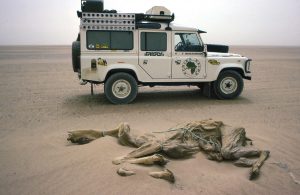 “When you travel alone, you must relate to the locals who speak another language, and it is not easy to understand and be understood. The travel experience is undoubtedly more intense. Another thing is that when I’m alone in my Land Rover I’m less visible, especially important when I have to go through risky areas or when I arrive in an isolated village, so as not to disrupt the routine of the inhabitants.”
“When you travel alone, you must relate to the locals who speak another language, and it is not easy to understand and be understood. The travel experience is undoubtedly more intense. Another thing is that when I’m alone in my Land Rover I’m less visible, especially important when I have to go through risky areas or when I arrive in an isolated village, so as not to disrupt the routine of the inhabitants.”
 “However, traveling alone exposes me more to the risks of common delinquency especially in big African cities, (I never had this kind of trouble in small villages, in the forest or in the desert). Another dangerous problem could arise from a serious physical injury in an isolated are, an accident, or a mechanical failure.”
“However, traveling alone exposes me more to the risks of common delinquency especially in big African cities, (I never had this kind of trouble in small villages, in the forest or in the desert). Another dangerous problem could arise from a serious physical injury in an isolated are, an accident, or a mechanical failure.”
“In 1988 in Niger, I drove on a flooded track with very deep holes. My Land Rover sucked in some water and stopped running. I understood immediately that the damage was serious. I started to disassemble the engine; three, maybe four connecting rods looked bent. I couldn’t do anything so I waited for someone to pass. After several hours a truck arrived and took me to the nearest village. Luckily a village blacksmith had rudimentary welding equipment. With the torch, we cut the connecting rods. With the one good rod I waited for someone to take me 200 km to Zinder, a town on the border with Nigeria. There I managed to find the other three connecting rods from a carcass of a Land Rover 109”. I then returned to the village and fixed the damaged pieces. Four days later I was back on the road to Cameroon.”
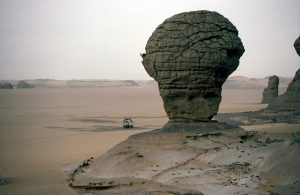 “Another time, in 1999, in North Kivu, Democratic Republic of the Congo, I navigated my way towards the remote Garamba National Park to see the very-threatened white rhinos. The area is dangerous — poachers and military stragglers from Sudan infest this forest, kill the animals and loot the villages.
“Another time, in 1999, in North Kivu, Democratic Republic of the Congo, I navigated my way towards the remote Garamba National Park to see the very-threatened white rhinos. The area is dangerous — poachers and military stragglers from Sudan infest this forest, kill the animals and loot the villages.
I’ve been driving slowly in big holes of mud for hours. Suddenly, on both sides of the track, hiding in the foliage, I see men wearing military camouflage suits, heavily armed with machines guns pointed at me. I didn’t think too much and I continued to accelerate with my heart in my throat. In those eternal seconds, I wondered when I would have heard the first shot. Maybe they didn’t shoot at me or maybe I didn’t hear it. I like to believe that there was someone in the car who protected me.”
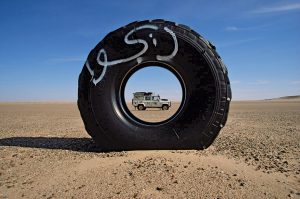 “Recently, in March 2017, I arrived in Brazzaville, Republic of Congo, where I applied for an entry visa for the Democratic Republic of the Congo. I had made the same request in Rome before leaving; then in Yaoundè, Cameroon, during the trip, and I was always refused for reasons of internal security. After useless days of waiting, I decided to give up and I returned with the 110 to Italy.”
“Recently, in March 2017, I arrived in Brazzaville, Republic of Congo, where I applied for an entry visa for the Democratic Republic of the Congo. I had made the same request in Rome before leaving; then in Yaoundè, Cameroon, during the trip, and I was always refused for reasons of internal security. After useless days of waiting, I decided to give up and I returned with the 110 to Italy.”
“Unfortunately, the political situation remains difficult [see Winter 2017 issue -ed.] but I will go back. I will put the car on a boat and travel upstream on the Congo Rover for 1,750 km to Kisangani, in the east of the country. It would be an extraordinary river trip and I hope I make as soon as possible.”
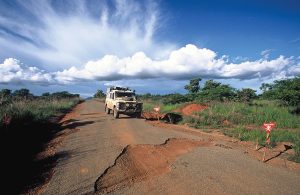 As for his parting advice to off-roaders in Italy, he replied, “Please stay on the designated paths and when it’s possible, go to the mountains and valleys when tracks are dry; in this way we leave way fewer traces of our passage.”
As for his parting advice to off-roaders in Italy, he replied, “Please stay on the designated paths and when it’s possible, go to the mountains and valleys when tracks are dry; in this way we leave way fewer traces of our passage.”
